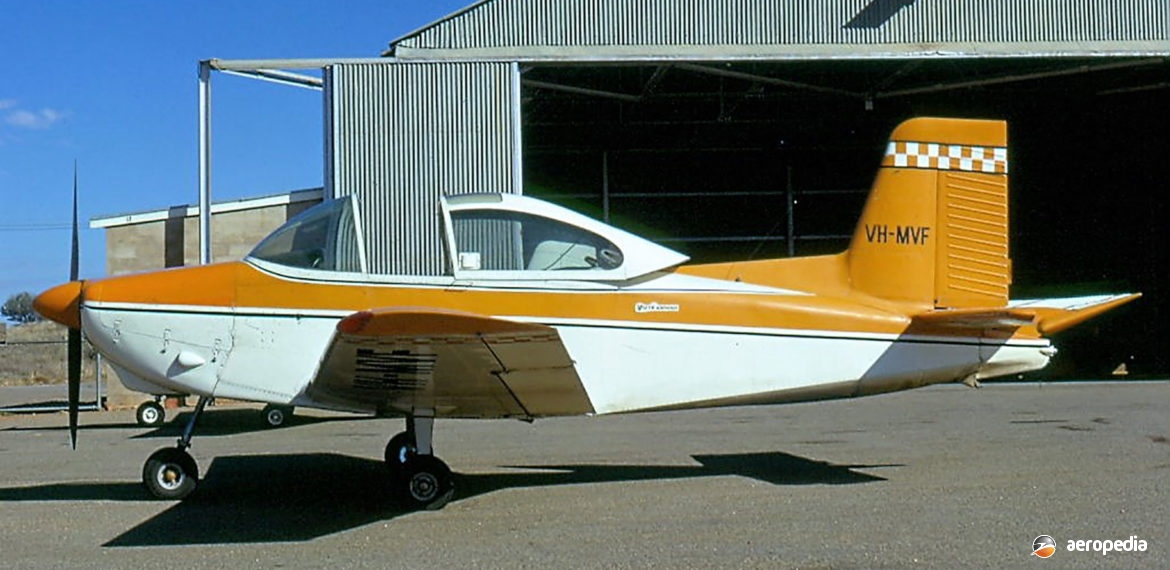Photograph:
Victa Airtourer 115 VH-MVF (c/n 19) at Broken Hill, NSW in March 1975 (David C Eyre)
Country of origin:
Australia
Description:
Two-seat light touring and training monoplane
Power Plant:
One 86 kw (115 hp) Lycoming O-235-C1B four-cylinder horizontally-opposed air-cooled engine
Specifications:
- Wingspan: 7.92 m (26 ft)
- Length: 6.55 m (21 ft 5 in)
- Height: 2.08 m (6 ft 10 in)
- Wing area: 11.2 m² (120 sq ft)
- Max speed at sea level: 230 km/h (143 mph)
- Max cruising speed at 1,220 m (4,000 ft): 211 km/h (131 mph)
- Economical cruising speed at 1,220 m (4,000 ft): 185 km/h (115 mph)
- Rate of climb: 274 m/min (900 ft/min)
- Stalling speed full flaps: 85 km/h (53 mph)
- Service ceiling: 4,275 m (14,000 ft)
- Time to climb from 305 m (1,000 ft) to 1,510 m (5,000 ft): 6 mins
- Range at economical cruising speed at 1,220 m (4,000 ft) with 45 mins reserve: 935 m (581 miles)
- Normal take-off run: 465 m (1,530 ft)
- Normal landing run: 478 m (1,570 ft)
- Fuel capacity: 132 litres (29 Imp gals)
- Empty weight: 475 kg (1,050 lb)
- Aerobatic gross weight: 703 kg (1,550 lb)
- Loaded weight: 748 kg (1,650 lb)
History:
Following the first flight of the Airtourer 100 on 12 December 1961, the first production aircraft flew in June 1962. At that time development was proceeding to provide a variant with a larger engine and this, the Airtourer 115 with a Lycoming O-235 engine, made its first flight in September 1962, the first production machine flying in February 1963. Both aircraft were basically identical except for the engine installed. They seated two under a sliding canopy and had side-by-side seating.
The Airtourer was unusual for the time in that it was fully aerobatic. Some interest was shown in it by other manufacturers, Piper Aircraft importing an example to the United States for testing. Production continued up until 1966 but by that time the competition was selling aircraft of similar capability at a lower price.
In 1969 Victa ceased production after 168 Airtourers had been built. The well-publicised reason given was the lack of Federal Government support for the Australian aviation industry, this making the production of aircraft in Australia, because of the low volume production compared to the mass production of aircraft in the United States, unprofitable.
Manufacturing rights for the Airtourer and the Aircruiser were then sold to Aero Engines Services Ltd of Hamilton, New Zealand. This company later merged with Air Parts Ltd to form Aerospace Industries. The latter company then commenced production of the type as the AESL Airtourer, and later offered it with a 112 kw (150 hp) Lycoming O-320 engine. In addition to the large proportion of Australian produced Airtourers, ten New Zealand-built Airtourers have appeared on the Australian register. The first New Zealand built aircraft (ZK-COZ – c/n 501) was flown for the first time on 12 October 1967.
Four AESL-built Airtourers were obtained by the RNZAF in 1970. These were known as the T6/24 (serials NZ1760 to NZ1763). Production of the Airtourer in New Zealand concluded in the early 1970s after more than 40 had been completed, a number being exported to the United Kingdom. The longest flight in an Airtourer was made by Cliff Tait in an AESL 115. He left New Zealand on 12 May 1969 in ZK-CXU (c/n 521) and returned on 1 August that year having travelled around the world, completing a distance of 53,097 km (33,000 miles) in a total of 288 flying hours. At that time it was the smallest aircraft to have completed the flight.
In November 2016 an Airtourer 115 (VH-RQG – c/n 104) joined the fleet of aircraft operated by the Historic Aircraft Restoration Society at Albion Park, NSW.

